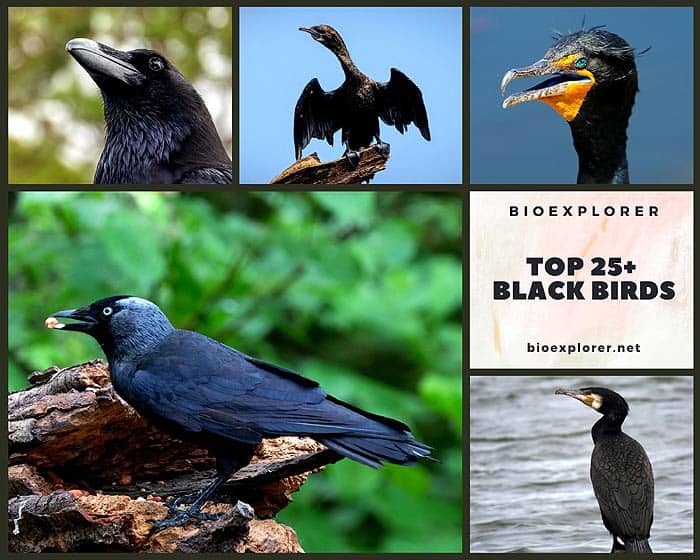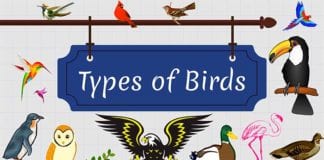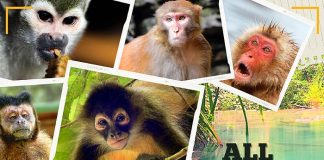Black Birds : One of the most fascinating animals bird amazing colors
On this page, a certain group of blackbirds has been explored due to eumelanin deposition in the plumage or iridescent feathers. Some birds can jump, run, and swim, and many birds can fly. Others of them are quite strange.
Let’s explore certain fascinating facts about these black birds.
What are different types of black birds?
Species Name: Corvus brachyrhynchos
Explore the intriguing American crow, a remarkable black bird-highly intelligent and adaptable. Learn about their physical characteristics, opportunistic eating habits, unique behaviors like 'funerals' and 'wakes,' and their social nature. Explore their population growth and ecological niche.
Species Name: Anhinga anhinga
Only a head that resembles a snake may be seen above the water, while a dark body swims covertly through the lake. The creature that sounds like the Loch Ness monster is actually an anhinga. This black waterbird stabs fish with its dagger-like beak while swimming underwater.
Species Name: Melanitta nigra
Black Scoters are a species of duck that form sizable winter flocks along the Atlantic and Pacific coasts. These blackbirds have 4 species: Black Scoter, Surf Scoter, Common Scoter, and White-winged Scoter. Explore Black Scoter characteristics, diet, and facts about them here.
Species Name: Coragyps atratus
The Black Vulture, scientifically known as Coragyps atratus, is an intriguing bird renowned for its resilience and adaptability. Belonging to the New World vulture family, this blackbird is commonly observed soaring through the skies across the Americas.
Species Name: Pica hudsonia
Black-billed Magpies (Pica hudsonia), with their flashy appearance and large bushel-basket nests in trees, significantly enhance western landscapes. Explore this dark bird's characteristics, nesting abilities, signs of self-recognition, diet, and more.
Species Name: Urile penicillatus
Explore the fascinating world of Brandt's Cormorant, a majestic black bird on the Pacific Coast. Learn about their physical characteristics, expert diving skills, unique nesting behaviors, and connection to the California Current. Discover their social nature, cooperative fishing habits, and diverse diet of fish species.
Species Name: Corvuscorone
Carrion Crows (Corvus corone) are common throughout England, Wales, and most of Scotland. Carrion Crows are only found on the eastern edges of the island of Ireland, whereas Hooded Crows are present everywhere. Explore their characteristics, diet, and fun facts here.
Species Name: Quiscalus quiscula
Step into the captivating world of the lanky Common Grackle! This fierce-looking black bird, known for its intriguing foraging habits and distinct 'buzzing' calls, thrives in varied habitats. Unearth their unique traits and behaviors here.
Species Name: Corvus corax
Discover the fascinating world of Common Ravens. Learn about their physical appearance, intelligence, hunting skills, group behavior, mimicry abilities, and exceptional memory. Uncover the secrets of these intelligent and captivating birds.
Species Name: Stephanoaetus coronatus
The Crowned Eagle (Stephanoaetus coronatus) is Africa's most powerful raptor. Delve into what makes this impressive eagle a skilled hunter, its unique breeding behaviors, critical conservation status, and why protecting this declining keystone forest predator matters.
Species Name: Nannopterum auritum
Explore the intriguing life of the Double-crested Cormorant, a black bird with a prehistoric appearance. Explore its physical traits, breeding behaviors, and nesting habits in North American habitats. Learn about its unique adaptations, including wing-drying habits and unconventional nesting materials.
Species Name: Corvus monedula
Explore the Eurasian Jackdaw (Corvus Monedula), a captivating black bird with its unique physical appearance, myths, gregarious nature, molting process, and ability to imitate human sounds. Discover the intriguing world of this intelligent and friendly species.
Species Name: Sturnus vulgaris
European Starlings (Sturnus vulgaris), first introduced to North America by Shakespeare enthusiasts in the nineteenth century, are now among the continent's most common songbirds. Explore their characteristics, diet, and fun facts about these black songbirds.
Species Name: Corvus ossifragus
The Fish Crow (Corvus ossifragus) is a common bird in some parts of the Southeast, resembling a smaller version of the American Crow but with a more nasal voice and a preference for areas near water. All black fish crows have black feathers, dark brown eyes almost black, black legs, and black beaks. Explore their characteristics and fun facts here.
Species Name: Phalacrocorax carbo
Explore the world of the Great Cormorant, a large seabird known for its unique physical traits and exceptional fishing skills. Discover its grooming habits, diving techniques, and swimming agility. Also known as the Great Black Cormorant, Black Shag, and Large Cormorant.
Species Name: Quiscalus mexicanus
The Great-tailed Grackle (Quiscalus mexicanus) is a large blackbird found across the Americas, recognized for its iridescent black and purple plumage. These displays are paired with various vocalizations, making their soundscape unique among songbirds. Explore their characteristics, diet, and fun facts.
Species Name: Quiscalus niger
The Quiscalus niger, or Greater Antillean grackle, is a unique Caribbean songbird thriving in human habitats across Cuba, Jamaica, Hispaniola and Puerto Rico. Learn about this gregarious bird's classification, physical appearance, vocalizations, range, nesting habits, behavior, and relationship to humans.
Species Name: Corvus hawaiiensis
Learn about the Hawaiian Crow (Corvus hawaiiensis), an intelligent and remarkable bird driven to near extinction. Discover facts on their unique adaptations, the threats they face, conservation efforts underway, and their deep cultural significance in Hawaiian society.
Species Name: Corvux cornix
The hooded crow (Corvus cornix) is a bird species belonging to the Corvus genus. It is widely distributed across Northern, Eastern, and Southeastern Europe and parts of the Middle East. Explore characteristics, diet and fun facts about hooded crows here.
Species Name: Microcarbo niger
These smaller yet equally intriguing relatives of the Indian cormorant charm with their unique physical attributes and social behavior, Little Cormorant is another blackbird on our list. Explore its physical characteristics and fun facts here.
Species Name: Corvus caurinus
The northwest crow (Corvus caurinus) solely inhabits the northeastern Pacific Ocean coast between southern Alaska and the northern tip of Washington. Explore their characteristics, habitats, diet and fun facts here.
Species Name: Urile pelagicus
Unlock the mysterious world of the black Pelagic Cormorant! Loyal to its nest, this remarkable deep-diving bird leads a solitary life on steep, rugged coastlines. Delve into their unique habits and striking physical characteristics.
Species Name: Corvus albus
Pied crows (Corvus albus) are widely distributed African birds. They are highly intelligent and opportunistic and share the jackdaw's fascination with shiny objects. Explore their characteristics and what do pied crows eat, and other fun facts.
Species Name: Melopyrrha portoricensis
Preview a striking rainforest specialist, the ebony Puerto Rican Bullfinch (Melopyrrha portoricensis) accentuated by bright splashes of orange, whose adaptation across wooded uplands can't safeguard its uncertain future outlook. Learn why targeted conservation pairing habitat protections with agricultural supports provides the integrated strategy needed to sustain this vivid and versatile island forager.
Species Name: Icterus portoricensis
Discover a uniquely vibrant island songbird, the Puerto Rican Oriole (Icterus portoricensis), where plumage bright as its voice contrasts prevailing theories on sexual dichromatism. Follow this adaptable species foraging on insects, fruits, and lizards across diverse wooded to developed areas as it steadfastly continues ancestral island lineages.
Species Name: Melanerpes portoricensis
Check the skills of Puerto Rico's sole endemic woodpecker, the Puerto Rican Woodpecker (Melanerpes portoricen), adept at chiseling into aged tree snags and woody fruits across protected island forests and tree groves. Appreciate the woodpecker's role as ecosystem architect engineering cavities subsequently used by various secondary nesting birds.
Species Name: Buphagus erythrorynchus
The red-billed oxpecker is a passerine bird found in the savannah of sub-Saharan Africa. These black birds assist grazers in getting rid of parasites but also expose wounds to infection. Explore their characteristics and fun facts here.
Species Name: Corvus frugilegus
Discover the fascinating world of rooks, large Corvidae birds found throughout Eurasia. Learn about their appearance, expert egg-robbing skills, unique anting behavior, special memory, and preference for local breeding grounds. Also, explore the similarities and differences between rooks and their crow cousins.
Species Name: Onychoprion fuscatus
The next black and white bird, Sooty Terns, is one of the most widespread tern species. Explore their unique physical attributes, social behavior, and intriguing adaptations, such as unihemispheric sleep that allows them to fly for months. Discover their significant cultural role on Easter Island and more.
Crows (Corvus genus - Corvidae family) are among the most widespread, recognizable, and intelligent birds across diverse habitats worldwide. Explore all 43 types of crows here.
Species Name: Pica nutalli
The Yellow-billed Magpie (Pica nuttalli) is a vibrant and lively bird species endemic to California, making it a unique and special part of the state's avian diversity. Explore these sociable black birds unique characteristics, distribution, and fun facts here.
Species Name: Agelaius xanthomus
Trace an endemic icterid, the radiant Yellow-shouldered Blackbird (Agelaius xanthomus), through extreme population plunges from habitat destruction to intensive recovery efforts centered on dry forests and mangroves. Learn how strategic protections aid this species' gradual rebound despite ongoing threats from cowbirds, rats, mongooses, and disease.
The yellow-winged blackbird (Agelasticus thilius) is a medium-sized songbird across much of South America. Males are jet black with bright yellow shoulder patches, while females are streaky brown.
What makes black birds black? The coloration of black plumage in various bird species, including blackbirds, grackles, starlings, and birds of paradise, is influenced by several biochemical elements. Here are some key factors:
Copper and Other Elements : Copper, along with zinc, iron, and manganese, is commonly present in feather pigments and plays a vital role in physiological Carotenoids and Feather Color : Not all red, orange, and yellow bird feathers contain carotenoids, as revealed by biochemical studies[1] .Melanin Pigmentation : Melanin, a widespread component of plumage coloration[2] , exhibits diverse patterns in bird species[3] .Systemic Glutathione (GSH) Levels : The development of eumelanin-based plumage coloration requires low GSH levels, although maintaining such levels can pose risks to the organism.The Complexity of Metal, Melanin, and Fitness Relationship : The interplay between metals, melanin, and fitness in birds is more intricate than initially anticipated, with melanin-based coloration influencing the effects of lead on fitness parameters.Unique Feather Nanostructure : Birds of paradise possess the blackest feathers, which have distinct nanostructures at the microscopic level. These structures enhance light scattering and absorption, resulting in a dull black appearance.These factors contribute to black-plumaged birds’ fascinating diversity, encompassing biological aspects and cultural perceptions.
Frequently Asked Questions What is the most common blackbird?
The most common blackbird is the Common Blackbird (Turdus merula ), found throughout most of Europe, North Africa, India, and southern China. The adult male of this species is all black except for a yellow eye-ring and bill and has a rich, melodious song; the adult female and juvenile have mainly dark brown plumage.
What does a blackbird signify?
The blackbird is a powerful symbol with many spiritual meanings and symbolism across different cultures and faith traditions. In ancient Egypt, blackbirds symbolized the cycle of life, representing rebirth and regeneration. In Japanese culture, the blackbird is associated with the God Izanagi .
What is the difference between blackbirds, crows, and ravens?
Blackbirds, crows, and ravens are all black-colored birds, but they belong to different families of birds. Here are the main differences between them based on some important features:
Blackbirds:
Blackbirds are part of the thrush family and have a solid but small bill. They are relatively smaller than crows and ravens, with a grey-colored neck. Black birds often have yellow eyes or bright yellow markings around their eyes. Blackbirds’ calls are much more melodious than crows and ravens. Crows:
Crows are part of the Corvidae family and have a dainty beak. They are smaller than ravens and have a rounded or squared-off tail. Crows are not glossy black but give off a violet-colored hue when seen from the right perspective. Crows tend to live in larger groups known as murderers and are more aggressive than ravens. Ravens:
Ravens are also part of the Corvidae family and have a much thicker and heavier beak than crows. They are larger than crows and have a wedge-shaped tail which is more obvious during flight. Ravens are glossy black and give out an iridescence in blue, green, or purple colors. Ravens travel alone or in pairs, producing a croaking and/or rattling sound. In summary, the main differences between blackbirds, crows, and ravens are their size, bill shape, tail shape, glossiness of their black color, and the sound they produce.
What bird looks like a blackbird?
Many birds look like blackbirds, and it can be difficult to distinguish them from one another. Some birds that look like blackbirds include crows, ravens, grackles, cowbirds, starlings, and red-winged blackbirds. While these birds may have predominantly black plumage, they may also have other colors or markings that can help with identification. For example, red-winged blackbirds have red and yellow patches on their wings, while grackles have iridescent feathers that can appear blue or purple in the sunlight.
What birds are mostly black?
Many birds are mostly black, and some of the most common ones include:
American Crow Common Raven European Starling Common Grackle Brown-headed Cowbird Red-winged Blackbird Brewer’s Blackbird Rusty Blackbird Boat-tailed Grackle Yellow-headed Blackbird Black-billed Magpie American Redstart These birds belong to different families with different sizes, shapes, and markings. Some have glossy black feathers, while others have black feathers with other colors or speckles. Some are more common in urban or suburban areas, while others are more likely to be found in fields and open spaces.
What are the blackbirds called?
There are many birds that are mostly black, and they belong to different families of birds. Some of the most common black birds include American Crow, Common Raven, European Starling, Common Grackle, Brown-headed Cowbird, Red-winged Blackbird, Brewer’s Blackbird, Rusty Blackbird, Boat-tailed Grackle, Yellow-headed Blackbird, Black-billed Magpie, and American Redstart. These birds have different sizes, shapes, and markings; some have glossy black feathers, while others have black feathers with other colors or speckles.
What is the black bird similar to a crow? There are many birds that look like crows but aren’t. Here are some of the most common ones:
Common Raven European Starling Common Grackle Brown-headed Cowbird Red-winged Blackbird Brewer’s Blackbird Rusty Blackbird Boat-tailed Grackle Yellow-headed Blackbird Black-billed Magpie American Redstart Tricolored Blackbird Bobolink Great-tailed Grackle Black Swift Black-headed Grosbeak Shiny Cowbird Bronzed Cowbird Black Rail Common Gallinule Chihuahuan Raven Western Jackdaw Pied Currawong Western Rook Alpine Chough These black birds belong to different families with different sizes, shapes, and markings. Some have glossy black feathers, while others have black feathers with other colors or speckles. Some are more common in urban or suburban areas, while others are more likely to be found in fields and open spaces.
Cite This Page
[1] – “Oxidative stress and information content of black and yellow plumage coloration: an experiment with greenfinches – PubMed” . Accessed June 08, 2023. Link .[2] – “The adaptive significance of dark plumage for birds in desert environments” . Accessed June 08, 2023. Link .[3] – “Diversity, physiology, and evolution of avian plumage carotenoids and the role of carotenoid-protein interactions in plumage color appearance – ScienceDirect” . Accessed June 08, 2023. Link .[4] – “Identifying Black Birds – K-12 Education” . Accessed June 16, 2023. Link .

















